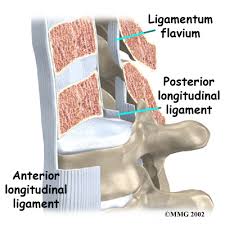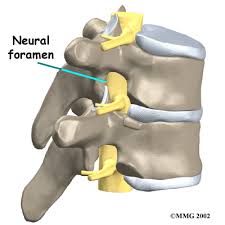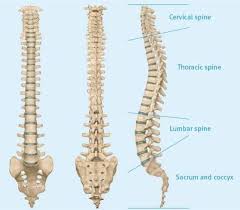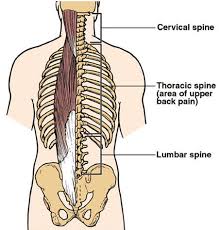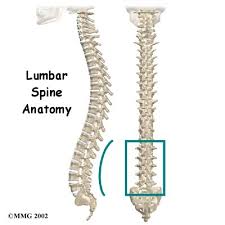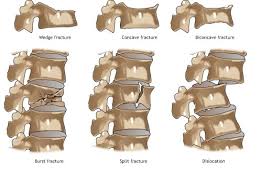
Your Spine - Anatomy
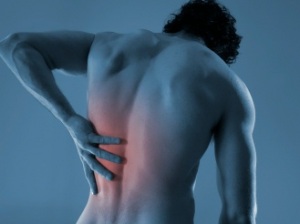
Are you feeling pain in your back? There could be a problem in your spinal column. MSR recommends spine care specialists in NY / NJ that diagnose and treat neck pain, leg pain and back pain. If your experiencing pain in your back or neck, call 1-800-949-6100 for a pain specialist nearest you.
Back pain could be the result of strained muscles, an injury to ligaments, bones, joints, and the disc. Neck pain, leg pain and back pain may stem from injury to the spine.
Spinal Nerve Chart:
| C1 | Blood supply to the head, pituitary gland, scalp, bones of the face, brain, inner and middle ear, sympathetic nervous system | Headaches, nervousness, insomnia, head colds, high blood pressure, migraine headaches, nervous breakdown, amnesia, chronic tiredness, dizziness, anxiety |
| C2 | Eyes, optic nerves, auditory nerves, sinuses, mastoid bones, tongue, forehead | Sinus trouble, allergies, pain around the eyes, earache, fainting spells, certain types of blindness, crossed eyes, deafness |
| C3 | Cheeks, outer ear, face bones, teeth, trigeminal nerve | Neuralgia, neuritis, acne or pimples, eczema |
| C4 | Nose, lips, mouth, eustachian tubes | Hay fever, runny nose, hearing loss, adenoids |
| C5 | Vocal cords, neck glands, pharynx | Laryngitis, hoarseness, throat conditions such as sore throat, neck pain |
| C6 | Neck muscles, shoulders, tonsils | Stiff neck, pain in upper arm, tonsillitis, chronic cough, croup |
| C7 | Thyroid gland, bursae in the shoulders, elbows | Bursitis, colds, thyroid conditions, pain in hands |
| T1 | Arms from the elbows down, including hands, wrists, and fingers, esophagus and trachea | Asthma, cough, difficult breathing, shortness of breath, pain in lower arms and hands |
| T2 | Heart, including its valves and covering, coronary arteries | Functional heart conditions (blood pressure & irregular heartbeats) and certain chest conditions |
| T3 | Lungs, bronchial tubes, pleura, chest, breast | Bronchitis, pleurisy, pneumonia, congestion, influenza, asthma |
| T4 | Gall bladder, common duct | Gall bladder conditions, jaundice, shingles, sensitivities to certain foods |
| T5 | Liver, solar plexus, circulation (general) | Liver conditions, fever, blood pressure problems, poor circulation, arthritis |
| T6 | Stomach | Stomach troubles, including nervous stomach, indigestion, heartburn, dyspepsia, acid reflux |
| T7 | Pancreas, duodenum | Ulcers, gastritis, regulation of blood sugar, energy loss |
| T8 | Spleen | Lowered resistance to infection or illness |
| T9 | Adrenal and supra-renal glands | Allergies, hives, energy swings |
| T10 | Kidneys | Kidney troubles, hardening of the arteries, chronic tiredness, nephritis, pyelitis |
| T11 | Kidneys, ureters | Skin conditions such as acne, pimples, eczema, boils |
| T12 | Small intestines, lymph circulation | Rheumatism, gas pains, certain types of sterility |
| L1 | Large intestines, inguinal rings | Constipation, colitis, dysentery, diarrhea, hernias |
| L2 | Appendix, abdomen, upper legs | Cramps, difficult breathing, minor varicose veins |
| L3 | Sex organs, uterus, bladder, knees | Bladder troubles, menstrual troubles such as painful or irregular periods, miscarriage, bed-wetting, impotency, change of life (menopause)symptoms, many knee problems |
| L4 | Prostate gland, muscles of the lower back, sciatic nerve | Sciatic pain, lower back pain, difficult, painful, or too frequent urination |
| L5 | Lower legs, ankles, feet | Poor circulation in the legs, swollen ankles, weak ankles and arches, cold feet, weakness in the legs, leg cramps |
| SACRUM | Hip bones, buttocks | Sacro-illac pain, spinal curvatures |
| COCCYX | Rectum, anus | Hemorrhoids, pruritus (itching), pain in tailbone on sitting |
The spinal column is made up of 33 vertebraee. This spinal provides the main support for your body, allowing you to stand upright, bend, and twist, while protecting the spinal cord from injury. A healthy spine is strong and flexible. That is as long as an individulal has strong bones and muscles, flexible tendons and ligaments. If there is a strain on the back causing injury, or disease an individual will start to feel pain.
There spine is made up of four regions: the cervical spine , thoracic spine, lumbar spine and sacral region.
- Cervical Spine: Located in the neck (C5-C6 & C6-C7).
- Thoracic Spine: Located in the upper back. The shoulder and back muscles can become irritated causing back pain.
- Lumbar Spine: Most lumber spine injuries effect the lower back, leg or foot.(L3 to L4 as well as L4 to L5 more susceptabke to strain).
- Sacral Region: “sacroiliac joint dysfunction” cause low back and/or leg pain. commonly affecting women.
Common causes of spinal cord injury:
- Car Accident. Auto and motorcycle accidents are the leading cause of spinal cord injuries.
- Slip and Fall. Spinal cord injury after age 65 is most often caused by a fall.
- Sports injury. Athletic activities, such as impact sports and diving in shallow water, cause about 8 percent of spinal cord injuries.
- Injuries at work. Repetitive motion wear and tear
Spine Images From Google ...
PATIENT SUCCESS
"I had serious lower back problem and required surgery.
After years of coping with accute pain management and drugs, I slipped and fell hurt my neck.
I had trouble turning my head and experienced unbearable neck pain.
After starting treatment with a pain and injury spinal damage doctor, I now the relief I needed for my neck, and lower back pain.
I have not had to use any pain medication since, and my posture, my balance, and my life style have greatly improved.
Thanks to DHD I've been given me back my life..."
Diagnosis:Spinal
- 1. Adult Idiopathic Scoliosis
- 2. Adult Scoliosis Cases
- 3. Adolescent Idiopathic Scoliosis
- 4. Adolescent Scoliosis Cases
- 5. Congenital Scoliosis
- 6. Neuromuscular Scoliosis
- 7. Kyphosis Cases
- 8. Flatback Cases
- 9. Stenosis
- 10. Cervical Herniated Disc
- 11. Lumbar Herniated Disc
- 12. Revision Surgery
- 13. Isthmic Spondylolisthesis
- 14. Degenerative Spondylolisthesis
- 15. Ankylosing Spondylitis

